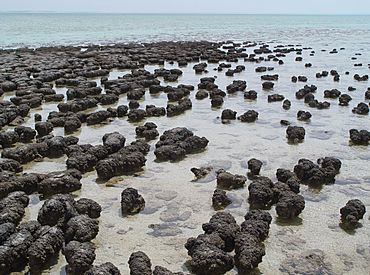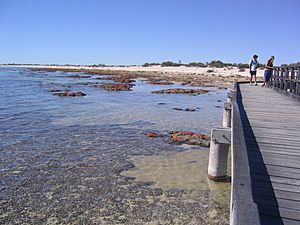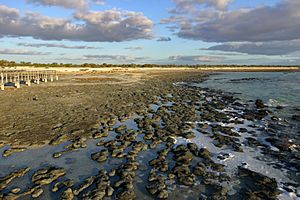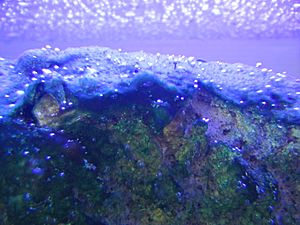Hamelin Pool Marine Nature Reserve facts for kids
Quick facts for kids Hamelin Pool Marine Nature ReserveWestern Australia |
|
|---|---|
|
IUCN Category Ia (Strict Nature Reserve)
|
|

|
|
| Nearest town or city | Denham |
| Area | 1,270 km2 (490.3 sq mi) |
| Managing authorities | WA Department of Parks and Wildlife |
| Website | Hamelin Pool Marine Nature Reserve |
| See also | List of protected areas of Western Australia |
The Hamelin Pool Marine Nature Reserve is a special protected area in Western Australia. It's part of Shark Bay, which is a UNESCO World Heritage Site. This amazing place is home to the world's largest and most diverse collection of living stromatolites. These unique rock-like structures are built by tiny living things and show us what life was like on Earth over 3.5 billion years ago!
Contents
Where is Hamelin Pool?
Hamelin Pool is located on the eastern side of Shark Bay in Western Australia. It's separated from the western part of Shark Bay by the Peron Peninsula. A smaller water area called L'Haridon Bight is just north of Hamelin Pool.
You can find the marine reserve next to the historic Hamelin Pool Telegraph Station. It's about 30 kilometers (19 miles) west of the Overlander Roadhouse. To get there, you take Hamelin Pool Road and then go through the Telegraph Station grounds. Visiting is free!
Exploring the Marine Reserve
The Hamelin Pool Marine Reserve covers a huge area of 1,270 square kilometers (490 square miles). It's one of only a few places on Earth where you can find living marine stromatolites. Other places include parts of the Caribbean Sea, the Persian Gulf, and the Great Salt Lake in Utah. However, Hamelin Pool has the most different kinds of stromatolites and tiny living things.
Discovering Stromatolites
Stromatolites in Hamelin Pool were first found in 1956 by surveyors looking for oil. These were the first living examples of structures created by cyanobacteria. Cyanobacteria are tiny, simple living things that use sunlight to make their own food. The ones in Hamelin Pool are direct relatives of the oldest life forms on Earth that could do this.
These living stromatolites look very similar to 3.5-billion-year-old stromatolite fossils found around the world. They are like a living record of Earth's earliest life. You can see them mostly along the shores of Hamelin Pool.
Why Hamelin Pool is Special
Hamelin Pool is very salty, about twice as salty as normal ocean water. This super salty environment is perfect for stromatolites to grow. It also stops other marine animals from living there and eating the bacteria.
The cyanobacteria live in huge groups on the seabed. There can be 3 billion of these tiny living things in just one square meter! They are the simplest life forms that use photosynthesis to create food and oxygen. Billions of years ago, they helped fill Earth's atmosphere with oxygen, long before plants even existed.
Stromatolites grow by trapping tiny bits of sand and crushed shells with their sticky surfaces. The bacteria then produce calcium carbonate, which acts like a glue, cementing these particles together. Over thousands of years, these layers build up. Some stromatolites here are pillars up to 1.5 meters (5 feet) tall! They grow very slowly, only about 0.5 millimeters (0.02 inches) each year.
Types of Stromatolites
There are three main types of stromatolites you might see:
- Sub-tidal columns: These are always underwater.
- Inter-tidal anvil or mushroom shapes: These are exposed to the air and sun during low tides. These are the ones you often see in pictures.
- Algal mats: These look like flat, black mud flats in the inter-tidal area, but they are actually living stromatolites.
To help visitors see these amazing structures without harming them, there's a special boardwalk at Hamelin Pool. This is the only place where the public can get close to the stromatolites because the environment is very fragile.
Inside the nature reserve, you'll also find Hutchinson Island and Pelican Island.
The Historic Telegraph Station
The historic Hamelin Pool Telegraph Station was built in 1884. The old Post Office, first built in 1886, is now the local Community Post Office.
There's a museum at the Telegraph Station that shares information about how stromatolites grow. It even has the only living stromatolites kept in an aquarium anywhere in the world! The museum also tells the story of how the historic Telegraph Station was built and operated back in the 1880s.
See also
 In Spanish: Reserva marina de Hamelin Pool para niños
In Spanish: Reserva marina de Hamelin Pool para niños







